Longitudinal In-Bed Pressure Signals Decomposition and Gradients Analysis for Pressure Injury Monitoring
Abstract
:1. Introduction
- We introduce a robust algorithm to separate the occlusion imposed by external objects from the body pressure signals.
- Detect body part for high-risk regions including head, sacrum, shoulders, and feet, directly from the spatial pressure distribution. Unlike previous works, we do not need any model fitting or multi-modality pose estimation networks.
- Track the high-risk regions and the corresponding pressure values over time. This is an essential step to formulate PI development as the major factors causing PI are (a) the surface pressure, (b) how long the pressure is exerted, and (c) the skin resistance to the building pressure.
2. Related Work
3. Proposed Method
3.1. Pre-Processing of the Pressure Data
3.1.1. External Object Removal
3.1.2. Signal Enhancement
3.2. Automatic Posture Detection
3.3. Automatic Body Part Detection
4. Experimental Setup and Results
5. Conclusions
Author Contributions
Funding
Institutional Review Board Statement
Informed Consent Statement
Data Availability Statement
Conflicts of Interest
References
- Mansfield, S.; Obraczka, K.; Roy, S. Pressure Injury Prevention: A Survey. IEEE Rev. Biomed. Eng. 2020, 13, 352–368. [Google Scholar] [CrossRef] [PubMed]
- Abubakar, I.; Tillmann, T.; Banerjee, A. Global, regional, and national age-sex specific all-cause and cause-specific mortality for 240 causes of death, 1990-2013: A systematic analysis for the Global Burden of Disease Study 2013. Lancet 2015, 385, 117–171. [Google Scholar]
- McInnes, E.; Jammali-Blasi, A.; Bell-Syer, S.E.; Dumville, J.C.; Middleton, V.; Cullum, N. Support surfaces for pressure ulcer prevention. Cochrane Database Syst. Rev. 2015. [Google Scholar] [CrossRef] [PubMed] [Green Version]
- Hospital Acquired Conditions Are Declining So Why Are Pressure Injuries on the Rise? Available online: https://www.advisory.com/daily-briefing/2019/11/14/pressure-injury (accessed on 15 December 2019).
- Walia, G.S.; Wong, A.L.; Lo, A.Y.; Mackert, G.A.; Carl, H.M.; Pedreira, R.A.; Bello, R.; Aquino, C.S.; Padula, W.V.; Sacks, J.M. Efficacy of monitoring devices in support of prevention of pressure injuries: Systematic review and meta-analysis. Adv. Ski. Wound Care 2016, 29, 567–574. [Google Scholar] [CrossRef] [PubMed]
- Cao, Z.; Martinez, G.H.; Simon, T.; Wei, S.E.; Sheikh, Y.A. OpenPose: Realtime Multi-Person 2D Pose Estimation using Part Affinity Fields. IEEE Trans. Pattern Anal. Mach. Intell. 2019. [Google Scholar] [CrossRef] [PubMed] [Green Version]
- Newell, A.; Yang, K.; Deng, J. Stacked hourglass networks for human pose estimation. In European Conference on Computer Vision; Springer: Amsterdam, The Netherlands, 2016; pp. 483–499. [Google Scholar]
- Szegedy, C.; Ioffe, S.; Vanhoucke, V.; Alemi, A.A. Inception-v4, inception-resnet and the impact of residual connections on learning. In Proceedings of the Thirty-First AAAI Conference on Artificial Intelligence, San Francisco, CA, USA, 4–9 February 2017. [Google Scholar]
- Sun, K.; Xiao, B.; Liu, D.; Wang, J. Deep high-resolution representation learning for human pose estimation. In Proceedings of the IEEE Conference on Computer Vision and Pattern Recognition, Long Beach, CA, USA, 15–20 June 2019; pp. 5693–5703. [Google Scholar]
- Grimm, R.; Sukkau, J.; Hornegger, J.; Greiner, G. Automatic patient pose estimation using pressure sensing mattresses. In Bildverarbeitung Für die Medizin 2011; Springer: Berlin/Heidelberg, Germany, 2011; pp. 409–413. [Google Scholar]
- Hsia, C.C.; Hung, Y.W.; Chiu, Y.H.; Kang, C.H. Bayesian classification for bed posture detection based on kurtosis and skewness estimation. In Proceedings of the HealthCom 2008-10th International Conference on e-health Networking, Applications and Services, Singapore, 7–9 July 2008; pp. 165–168. [Google Scholar]
- Yousefi, R.; Ostadabbas, S.; Faezipour, M.; Farshbaf, M.; Nourani, M.; Tamil, L.; Pompeo, M. Bed posture classification for pressure ulcer prevention. In Proceedings of the 2011 Annual International Conference of the IEEE Engineering in Medicine and Biology Society, Boston, MA, USA, 30 Auguat–3 September 2011; pp. 7175–7178. [Google Scholar]
- Ostadabbas, S.; Pouyan, M.B.; Nourani, M.; Kehtarnavaz, N. In-bed posture classification and limb identification. In Proceedings of the 2014 IEEE Biomedical Circuits and Systems Conference (BioCAS) Proceedings, Lausanne, Switzerland, 22–24 October 2014; pp. 133–136. [Google Scholar]
- Beltrán-Herrera, A.; Vázquez-Santacruz, E.; Gamboa-Zuñiga, M. Real-Time Classification of Lying Bodies by HOG Descriptors. In Lecture Notes in Computer Science (Including Subseries Lecture Notes in Artificial Intelligence and Lecture Notes in Bioinformatics); Springer: Cancun, Mexico, 2014; Volume 8495 LNCS, pp. 211–220. [Google Scholar]
- Cruz-Santos, W.; Beltrán-Herrera, A.; Vázquez-Santacruz, E.; Gamboa-Zúñiga, M. Posture classification of lying down human bodies based on pressure sensors array. In Proceedings of the 2014 International Joint Conference on Neural Networks (IJCNN), Beijing, China, 6–11 July 2014; pp. 533–537. [Google Scholar]
- Farshbaf, M.; Yousefi, R.; Pouyan, M.B.; Ostadabbas, S.; Nourani, M.; Pompeo, M. Detecting high-risk regions for pressure ulcer risk assessment. In Proceedings of the 2013 IEEE International Conference on Bioinformatics and Biomedicine, Shanghai, China, 18–21 December 2013; pp. 255–260. [Google Scholar]
- Pouyan, M.B.; Birjandtalab, J.; Nourani, M.; Pompeo, M.M. Automatic limb identification and sleeping parameters assessment for pressure ulcer prevention. Comput. Biol. Med. 2016, 75, 98–108. [Google Scholar] [CrossRef] [PubMed]
- Liu, J.J.; Huang, M.C.; Xu, W.; Sarrafzadeh, M. Bodypart localization for pressure ulcer Prevention. In Proceedings of the 2014 36th Annual International Conference of the IEEE Engineering in Medicine and Biology Society, Chicago, IL, USA, 26–30 August 2014; pp. 766–769. [Google Scholar]
- Pouyan, M.B.; Birjandtalab, J.; Heydarzadeh, M.; Nourani, M.; Ostadabbas, S. A pressure map dataset for posture and subject analytics. In Proceedings of the 2017 IEEE EMBS International Conference on Biomedical & Health Informatics (BHI), Orlando, FL, USA, 16–19 February 2017. [Google Scholar]
- Casas, L.; Navab, N.; Demirci, S. Patient 3D body pose estimation from pressure imaging. Int. J. Comput. Assist. Radiol. Surg. 2019, 14, 517–524. [Google Scholar] [CrossRef] [PubMed]
- Davoodnia, V.; Ghorbani, S.; Etemad, A. In-bed Pressure-based Pose Estimation using Image Space Representation Learning. arXiv 2019, arXiv:1908.08919. [Google Scholar]
- Davoodnia, V.; Etemad, A. Identity and Posture Recognition in Smart Beds with Deep Multitask Learning. In Proceedings of the 2019 IEEE International Conference on Systems, Man and Cybernetics (SMC), Bari, Italy, 6–9 October 2019; pp. 3054–3059. [Google Scholar]
- Matar, G.; Lina, J.M.; Kaddoum, G. Artificial neural network for in-bed posture classification using bed-sheet pressure sensors. IEEE J. Biomed. Health Inform. 2019. [Google Scholar] [CrossRef] [PubMed]
- Huang, W.; Wai, A.A.P.; Foo, S.F.; Biswas, J.; Hsia, C.C.; Liou, K. Multimodal sleeping posture classification. In Proceedings of the 2010 20th International Conference on Pattern Recognition, Istanbul, Turkey, 23–26 August 2010; pp. 4336–4339. [Google Scholar]
- Harada, T.; Sato, T.; Mori, T. Pressure distribution image based human motion tracking system using skeleton and surface integration model. In Proceedings of the 2001 ICRA, IEEE International Conference on Robotics and Automation (Cat. No. 01CH37164), Seoul, Korea, 21–26 May 2001; Volume 4, pp. 3201–3207. [Google Scholar]
- Clever, H.M.; Kapusta, A.; Park, D.; Erickson, Z.; Chitalia, Y.; Kemp, C.C. 3D Human Pose Estimation on a Configurable Bed from a Pressure Image. In Proceedings of the 2018 IEEE/RSJ International Conference on Intelligent Robots and Systems (IROS), Madrid, Spain, 1–5 October 2018; pp. 54–61. [Google Scholar]
- Azami, H.; Mohammadi, K.; Bozorgtabar, B. An Improved Signal Segmentation Using Moving Average and Savitzky-Golay Filter. J. Signal Inf. Process. 2012, 3, 39–44. [Google Scholar] [CrossRef] [Green Version]
- Savitzky, A.; Golay, M.J.E. Smoothing and differentiation of data by simplified least squares procedures. Anal. Chem. 1964, 36, 1627–1639. [Google Scholar] [CrossRef]
- Dominguez, C.L.; Hajari, N.; Ho, C.; Manzano, O.I.; Cheng, I. Human Body Parts Tracking from Pressure Data: Toward Effective Pressure Injury Assessment. In Proceedings of the 2021 International Conference on Human-Computer Interaction (HCI), Washington, DC, USA, 24–29 July 2021. [Google Scholar]
- Dalal, N.; Triggs, B. Histograms of oriented gradients for human detection. In Proceedings of the 2005 IEEE Computer Society Conference on Computer Vision and Pattern Recognition (CVPR’05), San Diego, CA, USA, 20–25 June 2005; Volume 1, pp. 886–893. [Google Scholar]
- Zhao, A.; Dong, J.; Zhou, H. Self-supervised learning from multi-sensor data for sleep recognition. IEEE Access 2020, 8, 93907–93921. [Google Scholar] [CrossRef]




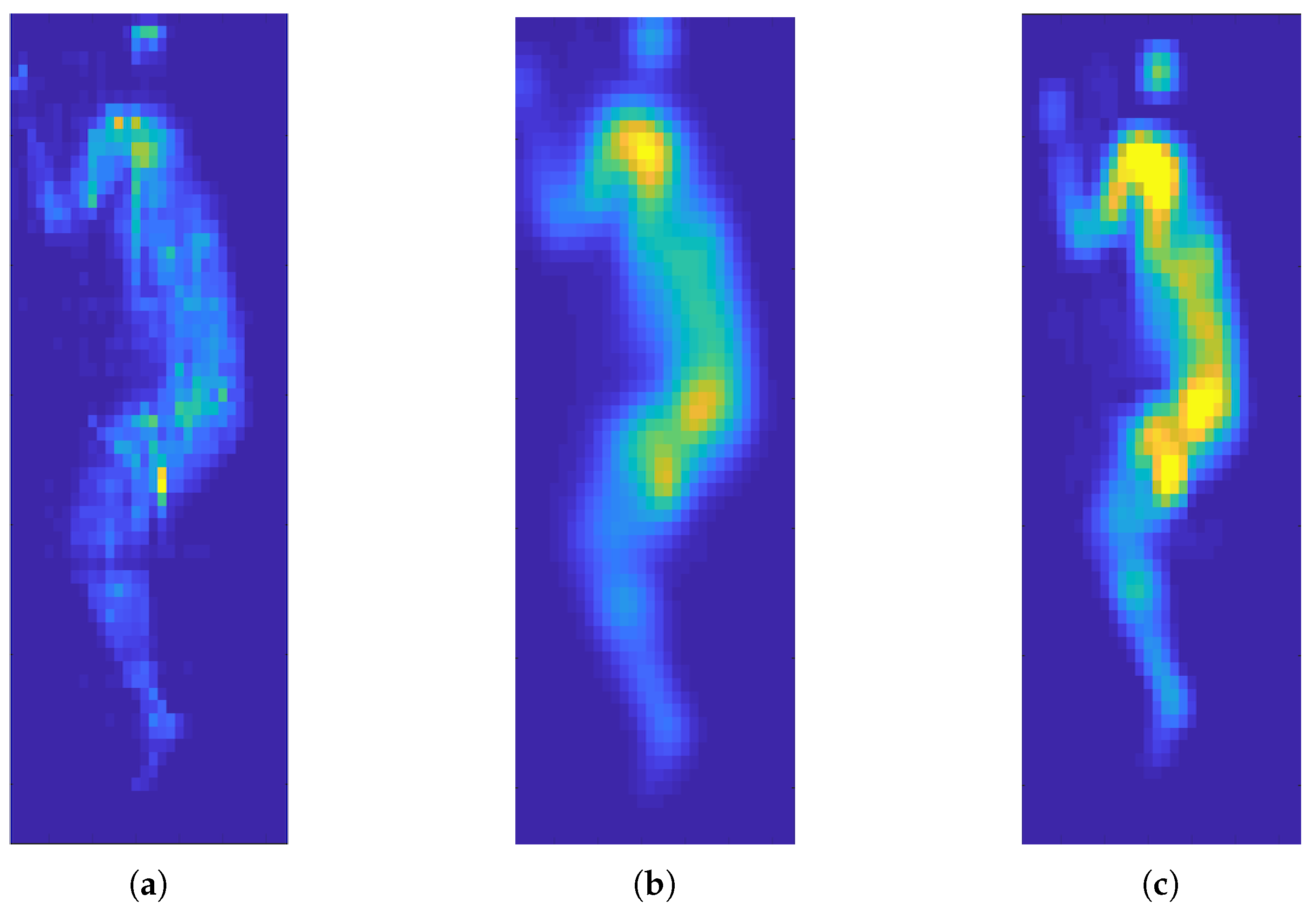

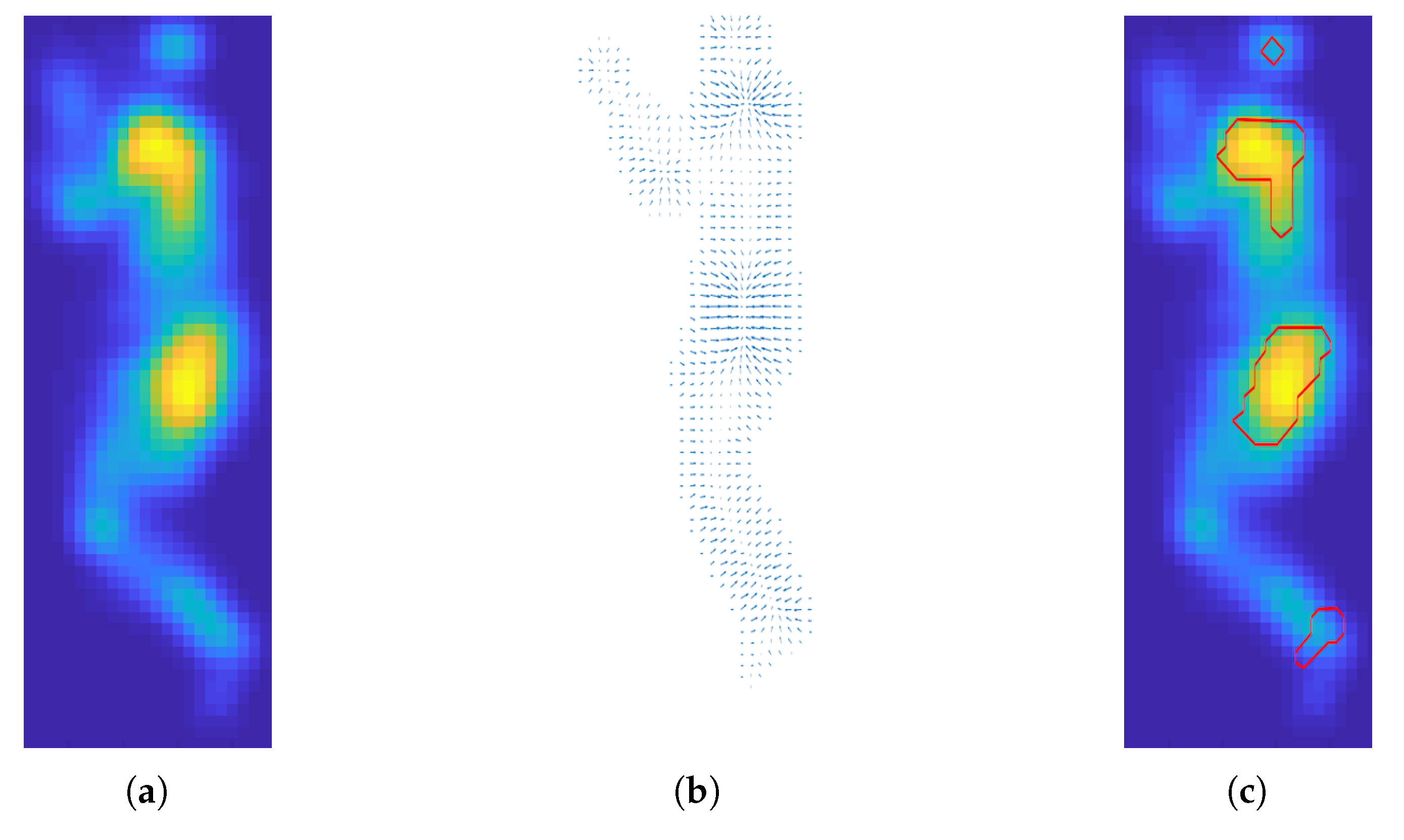
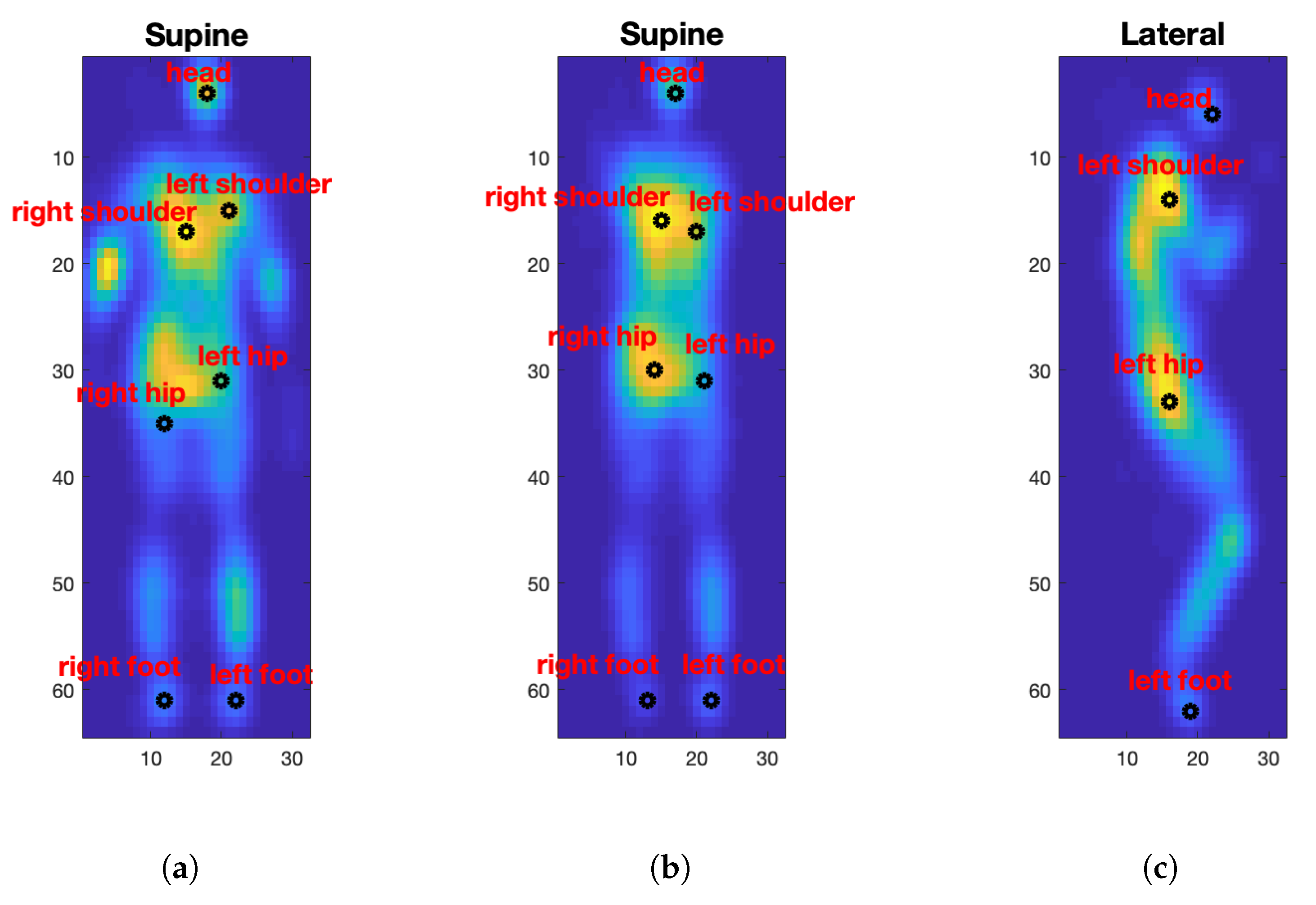
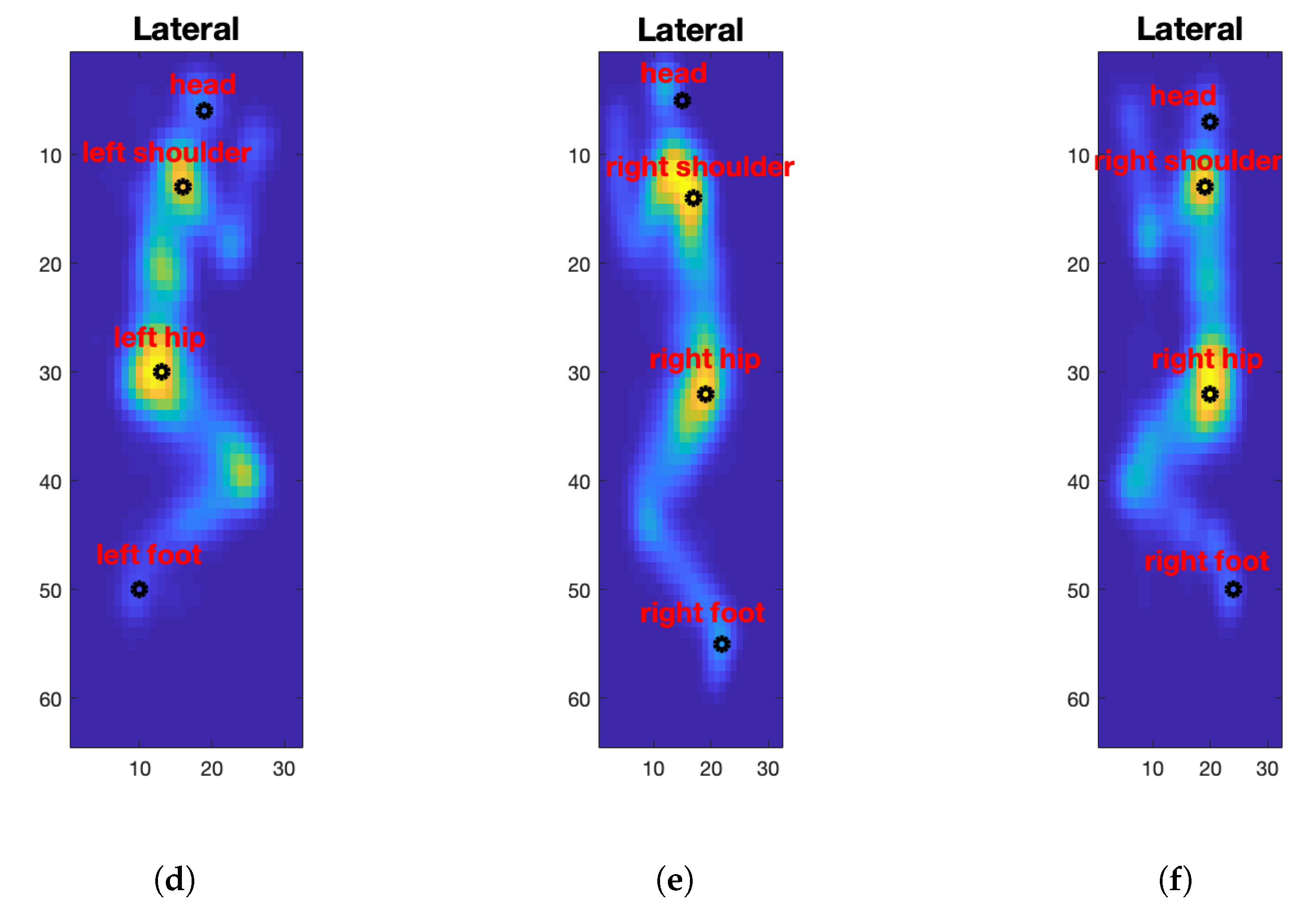
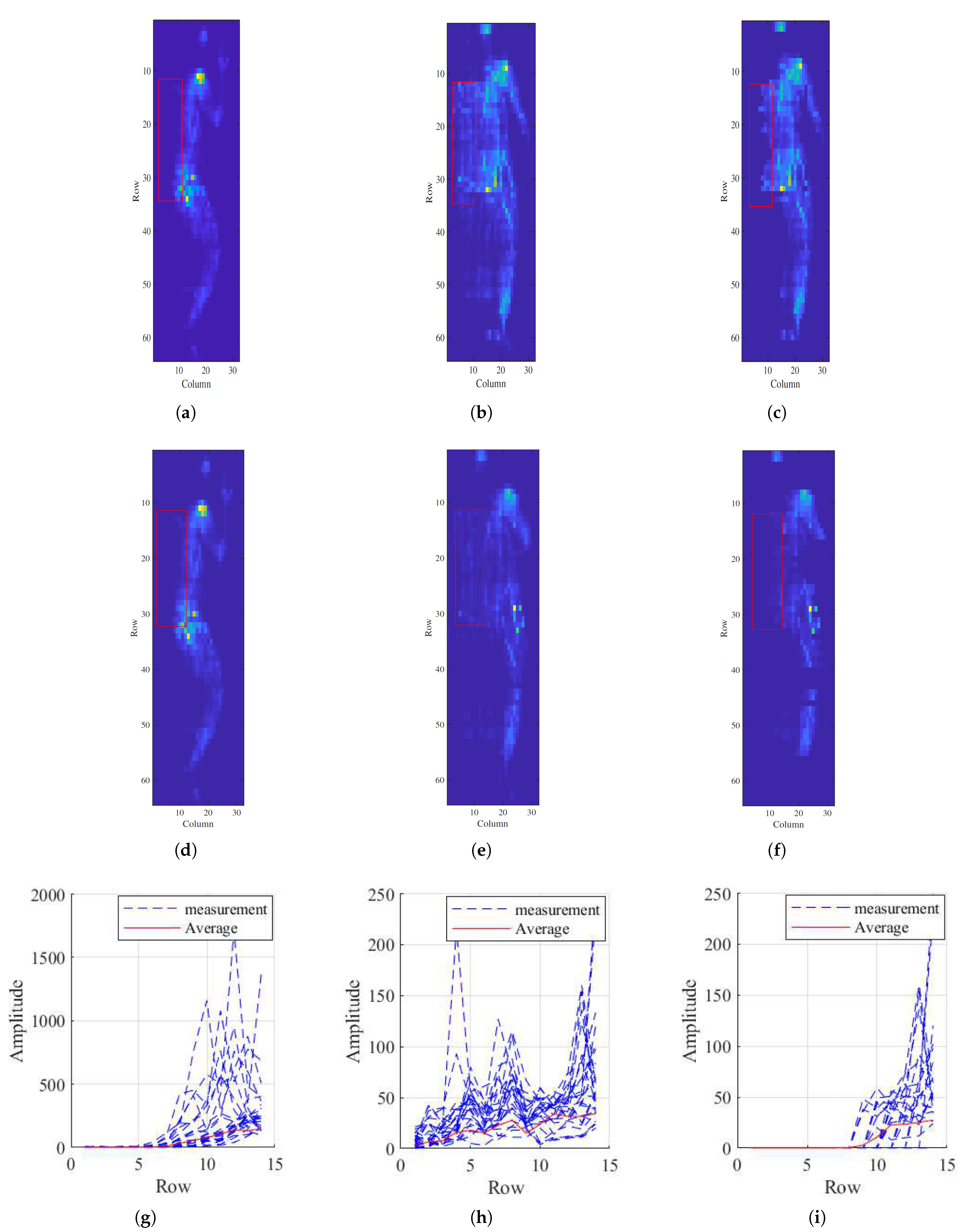

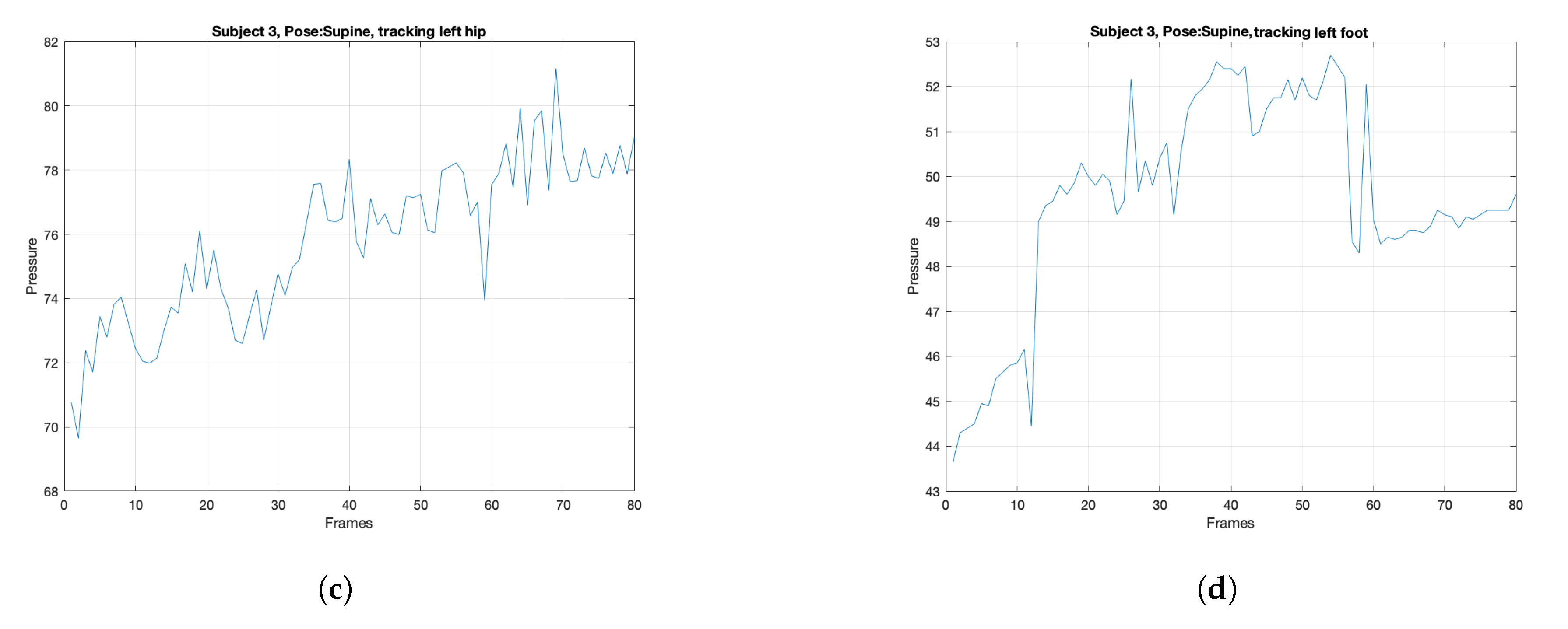
| S1 | S2 | S3 | S4 | S5 | S6 | S7 | S8 | S9 | S10 | S11 | S12 | S13 | |
|---|---|---|---|---|---|---|---|---|---|---|---|---|---|
| PSNR | 16.13 | 15.34 | 14.57 | 14.74 | 19.58 | 17.34 | 16.04 | 19.26 | 16.88 | 17.93 | 15.08 | 18.65 | 14.23 |
| RMSE | 0.102 | 0.112 | 0.129 | 0.124 | 0.080 | 0.087 | 0.130 | 0.083 | 0.092 | 0.080 | 0.115 | 0.085 | 0.128 |
| WHOG | ||||
| SVM | KNN | RF | SSRM [31] | |
| Supine | 99.98% | 99.99% | 99.93% | 99.90 |
| Right lateral | 99.99% | 100% | 99.98% | 98.48 |
| Left lateral | 99.99% | 99.99% | 99.95% | 99.57 |
| SHOG | ||||
| SVM | KNN | RF | SSRM [31] | |
| Supine | 99.95% | 98.31% | 99.91% | 99.90 |
| Right lateral | 100% | 98.21% | 99.95% | 98.48 |
| Left lateral | 99.95% | 99.88% | 99.95% | 99.57 |
Publisher’s Note: MDPI stays neutral with regard to jurisdictional claims in published maps and institutional affiliations. |
© 2021 by the authors. Licensee MDPI, Basel, Switzerland. This article is an open access article distributed under the terms and conditions of the Creative Commons Attribution (CC BY) license (https://creativecommons.org/licenses/by/4.0/).
Share and Cite
Hajari, N.; Lastre-Dominguez, C.; Ho, C.; Ibarra-Manzano, O.; Cheng, I. Longitudinal In-Bed Pressure Signals Decomposition and Gradients Analysis for Pressure Injury Monitoring. Sensors 2021, 21, 4356. https://doi.org/10.3390/s21134356
Hajari N, Lastre-Dominguez C, Ho C, Ibarra-Manzano O, Cheng I. Longitudinal In-Bed Pressure Signals Decomposition and Gradients Analysis for Pressure Injury Monitoring. Sensors. 2021; 21(13):4356. https://doi.org/10.3390/s21134356
Chicago/Turabian StyleHajari, Nasim, Carlos Lastre-Dominguez, Chester Ho, Oscar Ibarra-Manzano, and Irene Cheng. 2021. "Longitudinal In-Bed Pressure Signals Decomposition and Gradients Analysis for Pressure Injury Monitoring" Sensors 21, no. 13: 4356. https://doi.org/10.3390/s21134356
APA StyleHajari, N., Lastre-Dominguez, C., Ho, C., Ibarra-Manzano, O., & Cheng, I. (2021). Longitudinal In-Bed Pressure Signals Decomposition and Gradients Analysis for Pressure Injury Monitoring. Sensors, 21(13), 4356. https://doi.org/10.3390/s21134356







